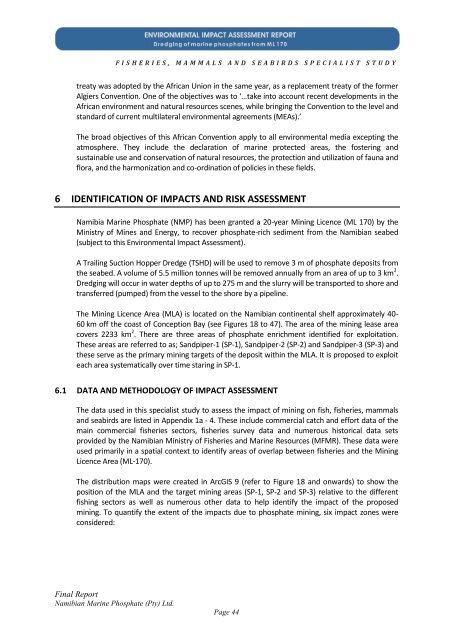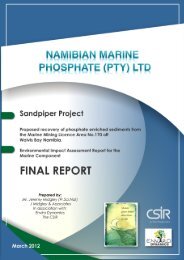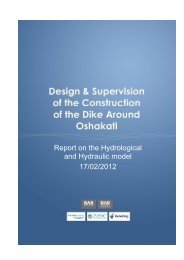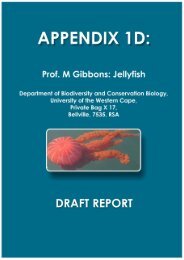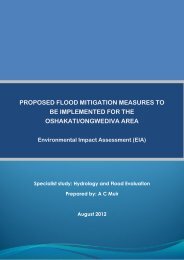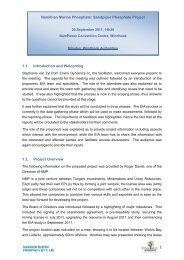Fisheries - Enviro Dynamics Namibia
Fisheries - Enviro Dynamics Namibia
Fisheries - Enviro Dynamics Namibia
Create successful ePaper yourself
Turn your PDF publications into a flip-book with our unique Google optimized e-Paper software.
F I S H E R I E S , M A M M A L S A N D S E A B I R D S S P E C I A L I S T S T U D Y<br />
treaty was adopted by the African Union in the same year, as a replacement treaty of the former<br />
Algiers Convention. One of the objectives was to ‘…take into account recent developments in the<br />
African environment and natural resources scenes, while bringing the Convention to the level and<br />
standard of current multilateral environmental agreements (MEAs).’<br />
The broad objectives of this African Convention apply to all environmental media excepting the<br />
atmosphere. They include the declaration of marine protected areas, the fostering and<br />
sustainable use and conservation of natural resources, the protection and utilization of fauna and<br />
flora, and the harmonization and co-ordination of policies in these fields.<br />
6 IDENTIFICATION OF IMPACTS AND RISK ASSESSMENT<br />
<strong>Namibia</strong> Marine Phosphate (NMP) has been granted a 20-year Mining Licence (ML 170) by the<br />
Ministry of Mines and Energy, to recover phosphate-rich sediment from the <strong>Namibia</strong>n seabed<br />
(subject to this <strong>Enviro</strong>nmental Impact Assessment).<br />
A Trailing Suction Hopper Dredge (TSHD) will be used to remove 3 m of phosphate deposits from<br />
the seabed. A volume of 5.5 million tonnes will be removed annually from an area of up to 3 km 2 .<br />
Dredging will occur in water depths of up to 275 m and the slurry will be transported to shore and<br />
transferred (pumped) from the vessel to the shore by a pipeline.<br />
The Mining Licence Area (MLA) is located on the <strong>Namibia</strong>n continental shelf approximately 40-<br />
60 km off the coast of Conception Bay (see Figures 18 to 47). The area of the mining lease area<br />
covers 2233 km 2 . There are three areas of phosphate enrichment identified for exploitation.<br />
These areas are referred to as; Sandpiper-1 (SP-1), Sandpiper-2 (SP-2) and Sandpiper-3 (SP-3) and<br />
these serve as the primary mining targets of the deposit within the MLA. It is proposed to exploit<br />
each area systematically over time staring in SP-1.<br />
6.1 DATA AND METHODOLOGY OF IMPACT ASSESSMENT<br />
The data used in this specialist study to assess the impact of mining on fish, fisheries, mammals<br />
and seabirds are listed in Appendix 1a - 4. These include commercial catch and effort data of the<br />
main commercial fisheries sectors, fisheries survey data and numerous historical data sets<br />
provided by the <strong>Namibia</strong>n Ministry of <strong>Fisheries</strong> and Marine Resources (MFMR). These data were<br />
used primarily in a spatial context to identify areas of overlap between fisheries and the Mining<br />
Licence Area (ML-170).<br />
The distribution maps were created in ArcGIS 9 (refer to Figure 18 and onwards) to show the<br />
position of the MLA and the target mining areas (SP-1, SP-2 and SP-3) relative to the different<br />
fishing sectors as well as numerous other data to help identify the impact of the proposed<br />
mining. To quantify the extent of the impacts due to phosphate mining, six impact zones were<br />
considered:<br />
Final Report<br />
<strong>Namibia</strong>n Marine Phosphate (Pty) Ltd.<br />
Page 44


